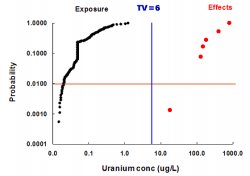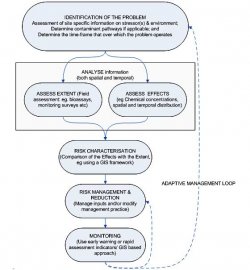Human and ecological Risk Assessment
 Consider the example of determining the risk of exposure to toxic levels of uranium to biota in Magela Creek waters downstream of Ranger mine. In this case there are two information sources for the assessment:
Consider the example of determining the risk of exposure to toxic levels of uranium to biota in Magela Creek waters downstream of Ranger mine. In this case there are two information sources for the assessment:
As illustrated in Figure 2 uranium levels for all exposure observations fall well under the effect thresholds and the risk probability for exposure to uranium at detrimental levels in Magela Ck is therefore close to zero.
Figure 2 Cumulative probability for exposure to uranium in Magela Ck, downstream of Ranger mine (1998-2005) and for potential effects (No-Observed-Effect-Concentration) of uranium on six species of native aquatic fauna (from ecotoxicological studies). TV = monitoring trigger value for uranium in Magela Ck.
 In this case the assessment endpoint used to evaluate impacts from off-site uranium contamination from Ranger mine is the conservation of the biological diversity of the ARR. Data from water quality monitoring of uranium and from laboratory toxicity testing for uranium using native aquatic species are the practical measurement endpoints used to represent potential exposure and effects, respectively. From this data risk of contamination by uranium via the surface water pathway can thereby be determined.
In this case the assessment endpoint used to evaluate impacts from off-site uranium contamination from Ranger mine is the conservation of the biological diversity of the ARR. Data from water quality monitoring of uranium and from laboratory toxicity testing for uranium using native aquatic species are the practical measurement endpoints used to represent potential exposure and effects, respectively. From this data risk of contamination by uranium via the surface water pathway can thereby be determined.
While risks of hazardous exposure to uranium (and other mine-related products) have been found to be extremely low in Magela Creek, a risk-reduction strategy is nevertheless in place. Objectives for water quality management are based on minimum dilution requirements for mine-related products in receiving waters of Magela Creek. The uranium limit of 6 µg/L recommended by the Supervising Scientist has been derived using local ecotoxicological data in accordance with the Australian Water Quality Guidelines to protect 99% of the species present. In the event that a limit is exceeded, an agreed and practical management response is identified. In this case, therefore, risk-reduction management is intrinsically linked with the regulation and controlled release of mine waste-waters, offsite. When used in conjunction with timely monitoring information, these guidelines provide the basis for the ongoing management and re-evaluation of risks to Magela Creek biota.


